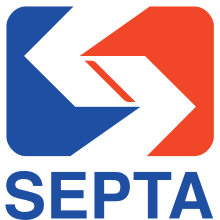سازمان ترابری جنوب شرقی پنسیلوانیا
| سازمان ترابری جنوب شرقی پنسیلوانیا | |||
|---|---|---|---|
 | |||
| اطلاعات | |||
| مکان | Delaware Valley | ||
| نوعی ترابری | |||
| تعداد خطوط | ۱۹۶ | ||
| تعداد ایستگاهها | ۲۹۰ | ||
| مسافران سالانه | 329,931,400 (2014)[۱] | ||
| مدیر اجرایی | Jeffrey D. Knueppel | ||
| مرکز فرماندهی | 1234 Market Street فیلادلفیا، پنسیلوانیا | ||
| وبگاه | SEPTA | ||
| اداره | |||
| ادارهکننده(ها) | SEPTA (one route in شهرستان مونتگومری، پنسیلوانیا contracted) | ||
| Reporting marks | SEPA SPAX | ||
| تعداد قطارها | ۲٬۲۹۵ | ||
| فنی | |||
| طول سیستم | ۴۵۰ مایل (۷۲۰ کیلومتر) | ||
| اندازه ریل | 4 ft 8 1⁄2 in (۱٬۴۳۵ mm) ریل استاندارد 5 ft 2 1⁄4 in (۱٬۵۸۱ mm)[۲][۳] | ||
| |||
سازمان ترابری جنوب شرقی پنسیلوانیا (انگلیسی: Southeastern Pennsylvania Transportation Authority) یا به صورت مخفف (انگلیسی: SEPTA) سازمان ترابری عمومی در فیلادلفیا، پنسیلوانیا است.
این سازمان که در سال ۱۹۶۵ تأسیس شده خدمات ترابری در فیلادلفیا و اطراف شهرستانهای دلاویر، مونتگومری، باکس و چستر همچون سرویسهای قطارشهری، تراموا، اتوبوس شهری و برقی فعالیت میکند.
سازمان SEPTA دارای ۱۹۶ خط، ۲۹۰ ایستگاه و ۷۲۰ کیلومتر طول خط راهآهن میباشد.
نقشه[ویرایش]

نگارخانه[ویرایش]
-
Retired Neoplan AN-460
-
New Flyer D40LF
-
New Flyer E40LFR
-
NovaBus LFSA
جستارهای وابسته[ویرایش]
منابع[ویرایش]
- ↑ "Transit Ridership Report Fourth Quarter and End-of-Year 2014" (PDF). American Public Transportation Association (APTA) (via: http://www.apta.com/resources/statistics/Pages/RidershipArchives.aspx). March 3, 2015. p. 26. Archived from the original (pdf) on 11 October 2017. Retrieved 2015-04-05.
{{cite web}}: External link in|publisher= - ↑ "The history of trolley cars and routes in Philadelphia". SEPTA. 1974-06-01. p. 2. Archived from the original on 14 July 2014. Retrieved 2014-06-11.
An early city ordinance prescribed that all tracks were to have a gauge of 2' 21⁄4"
- ↑ Hilton, George W.; Due, John Fitzgerald (2000-01-01). The Electric Interurban Railways in America. Stanford University Press. ISBN 978-0-8047-4014-2. Retrieved 2014-06-10.
Worst of all, not all city systems were built to the standard American and European gauge of 4'-81⁄2". Pittsburgh and most other Pennsylvania cities used 5'-21⁄2", which became known as the Pennsylvania trolley gauge. Cincinnati used 5'-21⁄2", Philadelphia 5'-21⁄4", Columbus 5'-2", Altoona 5'-3", Louisville and Camden 5'-0", Canton and Pueblo 4'-0", Denver, Tacoma, and Los Angeles 3'-6", Toronto an odd 4'-107⁄8", and Baltimore a vast 5'-41⁄2".
- Cheape, Charles W. (1980). Moving the masses: urban public transit in New York, Boston, and Philadelphia, 1880–1912. Harvard University Press. ISBN 0-674-58827-4.
- Pawson, John R. (1979). Delaware Valley Rails: The Railroads and Rail Transit Lines of the Philadelphia Area. John R. Pawson. ISBN 0-9602080-0-3.
- John F. Tucker Transit History Collection بایگانیشده در ۱ مه ۲۰۱۵ توسط Wayback Machine (1895-2002) at Hagley Museum and Library.(includes records of the pre-SEPTA Philadelphia Rapid Transit Company and the Philadelphia Transportation Company for the period 1907-1968.)
پیوند به بیرون[ویرایش]
| در ویکیانبار پروندههایی دربارهٔ سازمان ترابری جنوب شرقی پنسیلوانیا موجود است. |











